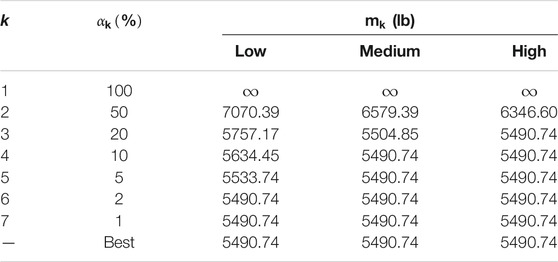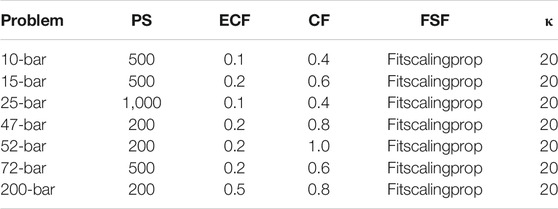- 1Faculty of Engineering Science, Department of Architecture, KU Leuven, Leuven, Belgium
- 2Faculty of Engineering Science, Department of Civil Engineering, KU Leuven, Leuven, Belgium
Metaheuristic optimization algorithms are strongly present in the literature on discrete optimization. They typically 1) use stochastic operators, making each run unique, and 2) often have algorithmic control parameters that have an unpredictable impact on convergence. Although both 1) and 2) affect algorithm performance, the effect of the control parameters is mostly disregarded in the literature on structural optimization, making it difficult to formulate general conclusions. In this article, a new method is presented to assess the performance of a metaheuristic algorithm in relation to its control parameter values. A Monte Carlo simulation is conducted in which several independent runs of the algorithm are performed with random control parameter values. In each run, a measure of performance is recorded. The resulting dataset is limited to the runs that performed best. The frequency of each parameter value occurring in this subset reveals which values are responsible for good performance. Importance sampling techniques are used to ensure that inferences from the simulation are sufficiently accurate. The new performance assessment method is demonstrated for the genetic algorithm in matlab R2018b, applied to seven common structural optimization test problems, where it successfully detects unimportant parameters (for the problems at hand) while identifying well-performing values for the important parameters. For two of the test problems, a better solution is found than the best solution reported so far in the literature.
1 Introduction
Metaheuristic algorithms are widespread in the literature on discrete and combinatorial optimization. They operate by applying stochastic (as opposed to deterministic) operators to explore the design space and to guide the search toward optimal designs, implying the need for statistical techniques to properly assess their performance. Nowadays, formal statistical analysis is considered a prerequisite for papers on non-deterministic optimization algorithms (Le Riche and Haftka, 2012; Haftka, 2016).
Metaheuristic algorithms are typically controlled by a number of algorithmic parameters, which can be modified to tune the search procedure to the optimization problem at hand. These parameters are referred to as control parameters in this article. The performance of a metaheuristic algorithm depends on three factors: 1) the specific optimization problem at hand, 2) the values of the control parameters, and 3) the random variability inherent to stochastic algorithms.
In the structural optimization community, it is common practice to benchmark newly proposed algorithms against one or more reference algorithms in order to assess their performance. Such benchmark studies are usually based on a simulation in which multiple optimization runs are performed (to compensate for the effect of the random seed) on a series of representative test problems (to compensate for the effect of the optimization problem). However, the effect of the control parameters is mostly ignored: their values are either chosen by intuition or convention, taken from other studies, or motivated by ad hoc experimentation, usually limited to changing one parameter value at a time (Chiarandini et al., 2007). From that moment on they remain fixed, although Bartz-Beielstein (2006) has shown that conclusions regarding algorithm performance do not necessarily apply to other parameter values.
Considering the wide range of metaheuristic algorithms currently in use, it is important to be able to assess their performance in an objective manner. For example, in a benchmarking context it would be fair to tune the control parameter values of all algorithms under consideration—using comparable resources—before moving on to the actual comparison (Eiben and Smit, 2011). Moreover, data on optimal control parameter values across multiple studies might reveal search strategies that work particularly well for a specific kind of optimization problem. In this regard, Hooker (1995) made the distinction between competitive and scientific testing, which, in the context of metaheuristic algorithms, is still very relevant today. Besides finding out which algorithm is better (competitive testing), it is important to investigate why this is the case (scientific testing). Hooker describes the former as “anti-intellectual,” as he believes that the emphasis on competition does not contribute to the sort of insight that will lead to the development of better algorithms in the long run.
Various methods exist to assess the performance of metaheuristic algorithms, including performance profiles (Dolan and Moré, 2002), data profiles (Moré and Wild, 2009), a probabilistic performance metric based on the effect size in statistics (Gomes et al., 2018) and statistical analysis methods by e.g. Charalampakis and Tsiatas (2019) and Georgioudakis and Plevris (2020). However, these methods are rarely used in a structural optimization context and there is no consensus on which method to use instead. A common approach is to perform several independent runs of the algorithm and to summarize the results using descriptive statistics, but the number of different runs and the statistics reported vary from study to study.
There is a trend in metaheuristic optimization to either reduce the number of (external) control parameters, as for example in the Newton metaheuristic algorithm by Gholizadeh et al. (2020), or to develop algorithms that update their parameters on-the-go, although these often have fixed parameters as well (Hutter et al., 2009b). Whether this is beneficial depends on the robustness of the algorithm with respect to the control parameters. An algorithm with many control parameters, whose values have little effect on performance or can be easily selected using rules of thumb, may still be preferable to an algorithm with few control parameters that need careful tuning. Therefore, a good performance assessment method should integrate the sensitivity of the algorithm with respect to its control parameter configuration.
This article presents a new method, designed to assess the performance of a metaheuristic algorithm in relation to the values of its control parameters. The scope is limited to control parameters whose values are constant throughout the optimization. The method is based on Monte Carlo simulation. The general idea is to perform multiple optimization runs, where the values of the control parameters vary randomly. From the resulting dataset, a subset of well-performing runs (e.g. the 10% best) is studied. The occurrence frequency of the various parameter values in this subset indicates which parameter values give rise to good performance. The threshold for “good” performance is gradually tightened, making the results more relevant, but also less accurate, as the well-performing subset will contain fewer samples. An adaptive importance sampling technique is used to sample good parameter values more often, ensuring sufficient accuracy throughout the procedure.
The proposed method is mathematically rigorous and has the advantage of being able to process any number of control parameters, both numerical and categorical, at the same time, presenting the results in a visual and intuitive way. It is intended as a tool to help developers of metaheuristic algorithms to test and benchmark their algorithm. Four possible applications are given below.
• The method can be used to investigate the sensitivity of an algorithm with respect to the control parameters. It identifies parameters that do not have a significant effect on performance and detects well-performing parameter values for the important parameters, helping developers to focus on the relevant parts of their algorithm.
• The method can also be used to select appropriate default values for the control parameters of a new algorithm, similar to the way in which the optimal and the default matlab values are compared for the genetic algorithm in Section 4.
• The method records the probability of achieving different levels of performance when parameter values are randomly selected from a set of user-defined “reasonable” options. The results can be compared with other algorithms to make statements about the overall performance in case no good parameter values would be known and the parameter configuration would be chosen arbitrarily.
• As a by-product, the method may generate new benchmark results for the community, as evidenced by the improvement over the best known solution for two of the test cases in Section 4.
The remainder of the article is structured as follows. Section 2 gives an outline of the state of the art on parameter tuning methods, providing an overview of ways to account for the influence of the control parameters. Section 3 presents the problem definition and describes the proposed methodology. Section 4 presents two numerical experiments, based on the genetic algorithm that is built into matlab, for seven test problems that are commonly used in the structural optimization literature. Section 5 provides final conclusions.
2 State of the Art in Parameter Tuning
Automated parameter tuning is a well-studied problem in the field of computational intelligence and machine learning. The following paragraphs summarize the state of the art.
2.1 Early Work
Research on the influence of control parameters started not long after the introduction of genetic algorithms and was initially mainly theoretical. Examples include Bäck and Schwefel (1993) and Rechenberg (1973). However, such theoretical models were either overly complex or required severe simplifications, making them of limited use in practical settings (Myers and Hancock, 2001). It became customary to study the effect of the control parameters through experimentation, using empirical models to test different parameter settings. Some authors, such as De Jong (1975), attempted to formulate universally valid control parameter configurations, until the No Free Lunch theorems (Wolpert and Macready, 1997) shattered the illusion of finding parameter values that are universally applicable.
2.2 Meta-Optimization
Alternatively, automatic tuning methods have been studied that tune the parameters for a single specific problem. A popular example is meta-optimization, which follows from the observation that choosing control parameters for maximal performance is an optimization problem in itself. In the meta-level problem, the control parameters are the design variables, and the performance of the algorithm is the objective function (often called the performance landscape). Depending on the nature of the control parameters, the meta-level problem is a mixed variable stochastic optimization problem that can be solved for example by iterated local search (ParamILS by Hutter et al. (2009b)) or by another metaheuristic algorithm (Nannen and Eiben, 2007; Ansótegui et al., 2009). The meta-optimizer can be applied either directly to the performance landscape (Grefenstette, 1986) or to a surrogate model of it (Audet and Orban, 2004).
2.3 Design of Experiments, Model-Based Optimization and Machine Learning
A popular class of tuning methods is based on the principles of Design of Experiments (DOE), which aims to maximize the information obtained from experiments in highly empirical fields of science such as biology and psychology. Common approaches include factorial designs, coupled with analysis of variance or regression analysis, e.g. Adenso-Diaz and Laguna (2006), Coy et al. (2001) and Rardin and Uzsoy (2001). The DOE methodology was later replaced by the Design and Analysis of Computer Experiments (DACE) methodology (Sacks et al., 1989), specifically created for deterministic computer algorithms (Bartz-Beielstein et al., 2004). Bartz-Beielstein et al. (2005) introduced Sequential Parameter Optimization (SPO), which uses Kriging techniques to build a predictive model of the performance landscape based on an increasing number of observations that are selected through an expected improvement criterion. Hutter et al. (2009a), Hutter et al. (2010) gave suggestions to further improve the method. Hutter et al. (2011) later introduced Sequential Model-based Algorithm Configuration (SMAC), extending model-based approaches to categorical parameters and sets of multiple problem instances using random forests (collections of regression trees). Independently, Dobslaw (2010) combined the DOE methodology with artificial neural networks as a basis for a parameter tuning framework.
2.4 Model-free Algorithm Configuration
In a separate line of work, statistical hypothesis testing has been used to compare different control parameter settings, for example in Czarn et al. (2004), Castillo-Valdivieso et al. (2002) and Xu et al. (1998). In this approach, evidence is gathered on the basis of experimental runs to test whether the considered parameter settings show a difference in performance that is significant enough to be distinguishable from stochastic noise. Nevertheless, the number of experimental runs that is required for sufficient statistical accuracy is often quite large (Yuan and Gallagher, 2007). Birattari et al. (2002) presented an efficient alternative with the F-Race algorithm, which progressively tests a number of (predefined) parameter configurations on one or more benchmark problems and eliminates inferior ones as soon as significance arises. Balaprakash et al. (2007) presented two improvement strategies for the F-Race algorithm, called sampling design and iterative refinement, and Yuan and Gallagher (2007) proposed a combination of F-Race and meta-optimization. More recently, López-Ibáñez et al. (2016) presented the irace package, offering iterated racing with a restart mechanism to prevent premature convergence and elitist racing to ensure that the best parameter configurations are tested most thoroughly. Li et al. (2017) introduced Hyperband, formulating the parameter tuning problem as an infinite-armed bandit problem, adaptively allocating more resources to promising parameter configurations in order to enhance random search. Falkner et al. (2018) combined Hyperband with Bayesian optimization in the BOHB (Bayesian optimization and Hyperband) method.
2.5 Parameter Tuning in Structural Optimization
In a structural optimization context, research into parameter tuning has received little attention so far. However, there have been several studies on parameter control, where parameter values are updated during the optimization process. For a general overview of parameter control methods, the reader is referred to Karafotias et al. (2015). Examples of parameter control applied to structural optimization include Hasançebi (2008) for evolutionary strategies, Hasançebi et al. (2009) for harmony search, Nickabadi et al. (2011) for particle swarm optimization and Kaveh and Farhoudi (2011) for metaheuristic algorithms in general.
The present authors have recently proposed a new parameter tuning method for structural optimization (Dillen et al., 2018). The method uses Monte Carlo simulation to estimate the distribution of performance of a metaheuristic algorithm under the condition that control parameter x has value y. Although this method is able to correctly reflect the effect of the dominant control parameters, it has difficulty in coping with effects that are due to parameter interactions: if a particular value of one control parameter only performs well in combination with a particular value of another control parameter, this will not be detected by the method.
3 Problem Definition and Methodology
3.1 List of Symbols
Table 1 presents an overview of the symbols that are used in the text. By convention, vectors are represented by bold characters. A function
3.2 General Approach
The following paragraphs establish a solid mathematical basis for the performance assessment problem and continue with the derivation of a Monte Carlo estimator and an importance sampling estimator for the statistic of interest. Next, the relevant properties of ratio estimators are briefly discussed. After that, the characteristics of a good importance sampling distribution are described. Finally, a method is given to iteratively update the importance sampling distribution based on adaptive importance sampling.
3.3 Problem Definition
To model the uncertainty in the simulation, we introduce a probability space
Suppose we want to assess the performance of a metaheuristic algorithm
is a function that maps the sample space
In order to proceed with the assessment, an appropriate performance measure is required. This is typically a scalar that is a function of either the objective function value, the number of function evaluations, or a combination of both, see e.g. Eiben and Smit (2011). Let “perf
We proceed by defining the statistic of interest, which we call
This equation can be interpreted as a Bayesian inference problem, where an initial guess for good control parameter values
3.4 Monte Carlo Estimator
We proceed by deriving a Monte Carlo estimator for the denominator
with
where
where
where
The relative accuracy of the estimator is given by its coefficient of variation (c.o.v.), which is defined as the standard deviation relative to the mean:
For different sets of samples, the value of the Monte Carlo estimate
3.5 Importance Sampling
The accuracy of the estimator can be improved by importance sampling, a variance reduction technique in which samples are drawn from a probability distribution other than the original distribution. The term “importance sampling” derives from the idea that it is better to concentrate the samples where they are most important to the target function, rather than spreading them out evenly (Hammersley and Handscomb, 1964). The mismatch between the original and the new sampling distribution is corrected by assigning importance weights to the individual samples, in order to avoid bias in inferences based on the simulation.
Let
as long as
with
where the expectation
3.6 Ratio Estimator
From the previous Section we have obtained an unbiased estimator for the denominator of the statistic of interest in Eq. 3. The estimator for the numerator
This is further elaborated as follows:
where
with
The estimators are well-defined everywhere except when
3.6.1 Bias Correction
Ratio estimators are biased, even if the estimators in the numerator and denominator are not. Methods that correct for this bias are readily available, examples of which include Beale’s estimator (Beale, 1962) and the jackknife estimator (Choquet et al., 1999). However, the bias will asymptotically approach 0 as
3.6.2 Variance Approximation
There is no exact expression for the variance of a ratio estimator. The following approximation is commonly used (Stuart and Ord, 1994):
where
and
where
3.7 Choosing an Appropriate Proposal Distribution
The effectiveness of the importance sampling approach depends directly on the choice of proposal distribution. The proposal distribution will be chosen to minimize the variance of the estimator in the denominator, as this is the same for all parameter/value combinations. Let the true value of the denominator be denoted by μ. The theoretical optimum for the proposal distribution is
which gives
it becomes clear that the optimal proposal distribution has mass only at those values
The optimal proposal distribution
In this equation,
with
The proposal distribution is used to compute the importance weights for the individual samples. The value of the importance weight
The factors
3.8 Updating the Proposal Distribution
Several updating schemes may be adopted for the proposal distribution g. It can be updated every time a sample is drawn, but then the samples will not be i.i.d., which means that no variance estimates can be computed. Alternatively, the simulation can be subdivided into multiple stages, where g is updated at the end of each stage. In the initial stage, the proposal distribution g is equal to the original distribution f. From then on, g is computed based on the samples in all previous stages. Within each stage k, the samples are i.i.d., and can be used to calculate in-stage estimates
This article uses a variant of the latter approach, as it allows the performance threshold value
The method proceeds as follows. First, let
after which the first stage is completed. Next, the samples from stage 1 are used to compute a rough estimate
where
(Owen and Zhou, 1999). As soon as this estimate is sufficiently accurate, a rough estimate
The continuation scheme for the performance threshold is based on percentile values, where
The optimal way to combine the in-stage estimates is to use weight factors
which will minimize the variance of the final estimator (Owen and Zhou 1999). However, the true variance of the in-stage estimates is unknown, and plugging in approximations might introduce bias. Instead, Owen and Zhou (1999) recommend to use the square root rule, a deterministic weighting scheme with weight factors proportional to
in which
4 Numerical Experiments and Discussion
As a test case, the new method is used to assess the performance of the genetic algorithm (GA) that comes with matlab R2018b. We consider six control parameters in total: four parameters specific to the GA (PopulationSize, EliteCountFraction, CrossoverFraction, and FitnessScalingFcn), one penalty parameter κ that determines the degree to which infeasible designs are penalized (following the approach by Rajeev and Krishnamoorthy (1992), see Supplementary Appendix SB)) and one Dummy parameter that has no effect and serves as a reference. Note that it is not required to know how the control parameters work in order to interpret the results, which is one of the strengths of the method. The GA starts by randomly creating an initial population (which is not necessarily feasible) and stops when the relative change of the objective function value over the last 50 generations becomes smaller than the tolerance value of 10−6 (both are default values), or when a user-defined limit on number of function evaluations is exceeded. If the final solution is feasible, the performance measure is taken as the objective function value reported by the algorithm. If the final solution is infeasible, the performance measure is set to infinity, preventing the run from being included among the well-performing results.
As test cases, we consider seven discrete truss sizing optimization problems for which the objective is to minimize structural weight. These are the 10-, 15-, 25-, 47-, 52-, 72-, and 200-bar truss problem, all of which have been used as test cases in the literature before, e.g. in Rajeev and Krishnamoorthy (1992), Camp and Bichon (2004), Lee et al. (2005), Ho-Huu et al. (2016), and Degertekin et al. (2019). Their respective problem formulations are given in Supplementary Appendix SB. All problems are subjected to constraints on member stresses and nodal displacements.
In the following subsections, three numerical experiments are discussed. The first experiment investigates whether well-performing values for the control parameters depend on the computational budget that is given to the GA, which corresponds to the maximum number of function evaluations (structural analyses) it is allowed to perform within a single run. The second experiment compares the best-performing control parameter values for similar optimization problems of different sizes, and investigates whether any trends can be observed. In both experiments, the estimators
4.1 Impact of the Computational Budget
The first experiment investigates the impact of the computational budget of the GA when applied to the 10-bar truss problem. Three Monte Carlo simulations are performed, in which the algorithm is given a computational budget of 104, 105, and 106 function evaluations. The results are presented as heat maps in Figures 1–3. Each heat map represents the sequence of probability distributions, corresponding to the different stages in the simulation, for a single control parameter. The rows of the heat map show the distribution of control parameter values within a single stage, where the top 1% of results (highlighted in red) will be most representative of the optimum. The mode of this distribution (darkest in color) is the parameter value that occurs most often in this subset. The parameter value that is most likely to give good performance has the highest probability of occurring in the well-performing subset, the value that is second most likely has the second highest probability, and so on. When applicable, the matlab default values are shown in bold.3 The width of the 95% confidence interval equals four times the standard deviation
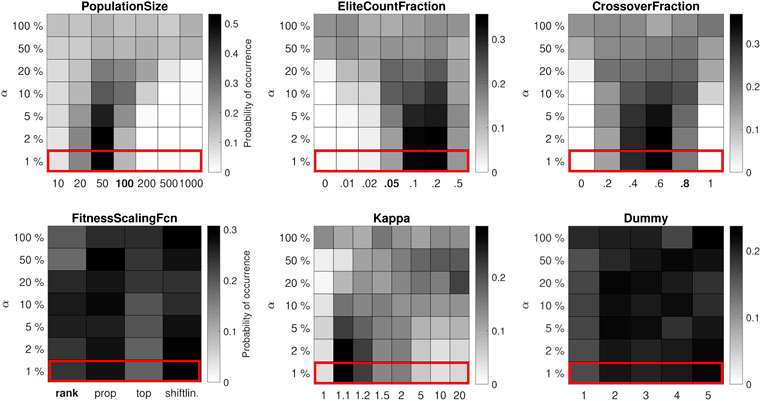
FIGURE 1. Distribution of control parameter values for the 10-bar truss test problem, where each run of the algorithm has a relatively low budget of 104 function evaluations. The performance of the GA is significantly affected by the control parameter values.
The results for the low-budget case (104 function evaluations) are shown in Figure 1. The GA finds the best known solution to the problem in 2% of runs, making the results for the top 1 and 2% identical. The best-performing value for the PopulationSize is 50, which corresponds to a maximum of 200 generations. The best-performing EliteCountFraction (the fraction of good designs that is maintained between generations) is somewhere in the range of 0.1–0.2, and the best-performing value for the CrossoverFraction is 0.6. All probability distributions in the top 1% appear to be unimodal, with the mode of the distribution for the PopulationSize being the most distinct. The distribution of values for the penalty parameter has a sharp peak near
For the medium-budget case (105 function evaluations) in Figure 2, the best-performing value for the PopulationSize is 500, which again corresponds to a maximum of 200 generations. The mode of the other parameter value distributions is similar to the low-budget case, but the variance is generally larger: the best-performing values are the same, but the GA is less sensitive to the control parameters. The same goes for the high-budget case (106 function evaluations) in Figure 3, where it is better to use a PopulationSize of 1,000 (and maybe larger), which still allows the algorithm to run for up to 1,000 generations. Unsurprisingly, a clear trade-off is observed between the size of the population on the one hand and the maximum number of generations on the other. Furthermore, the results confirm that the impact of the control parameters is largest when the computation budget is small and less pronounced otherwise, in line with classic (theoretical) proofs that many metaheuristic algorithms are guaranteed to find the global optimum if one lets them run indefinitely (Rudolph, 1994).
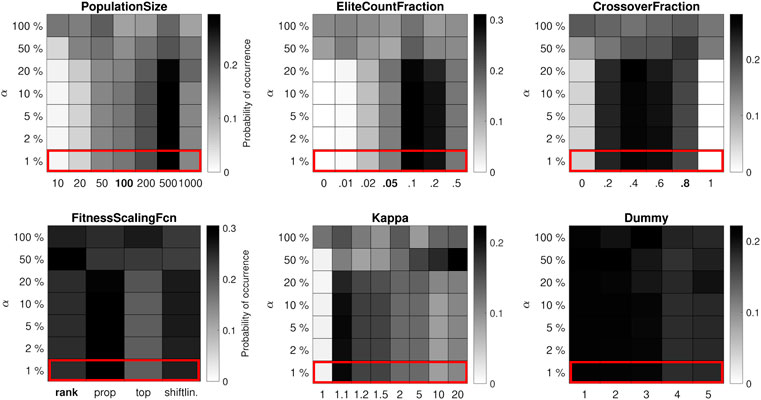
FIGURE 2. Distribution of control parameter values for the 10-bar truss test problem, where each run of the algorithm has a medium budget of 105 function evaluations. The performance of the GA is less affected by the control parameter values.
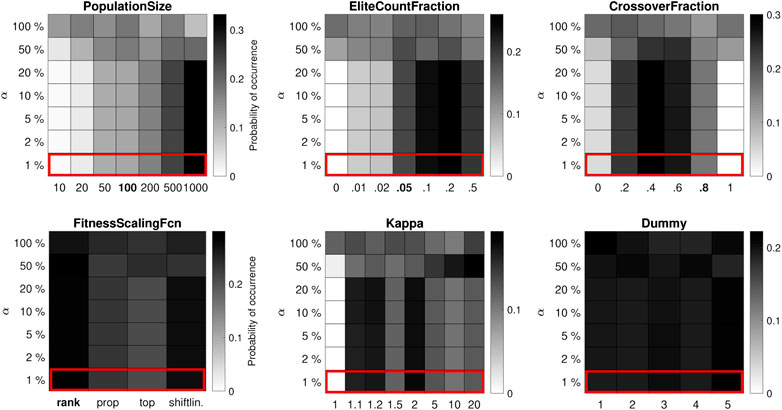
FIGURE 3. Distribution of control parameter values for the 10-bar truss test problem, where each run of the algorithm has a high budget of 106 function evaluations. Apart from a few extremes, the effect of the control parameter values is less important.
It should be noted that parameter dependencies cannot be read directly from the figures. However, the relevant dependencies (those that give rise to good performance) are implicitly included in the well-performing subset of results from the Monte Carlo simulation. Limiting inferences to this subset prevents unimportant parameter interactions from obscuring the conclusions.
The performance threshold values
4.2 Comparison Between Multiple Test Problems
The second experiment compares the best-performing control parameter values for all seven test problems and aims to determine whether any general conclusions can be drawn. In all test problems, the GA is limited to 105 function evaluations per run. The results for the 10-bar truss problem have already been presented in Figure 2. The results for the 25-, 52-, 47-, and 200-bar truss problems are shown in Figures 4–7, in order of increasing number of design variables. The Dummy parameter is omitted. At the end of the section, the results for the complete set of test problems are analyzed for trends regarding well-performing parameter values.
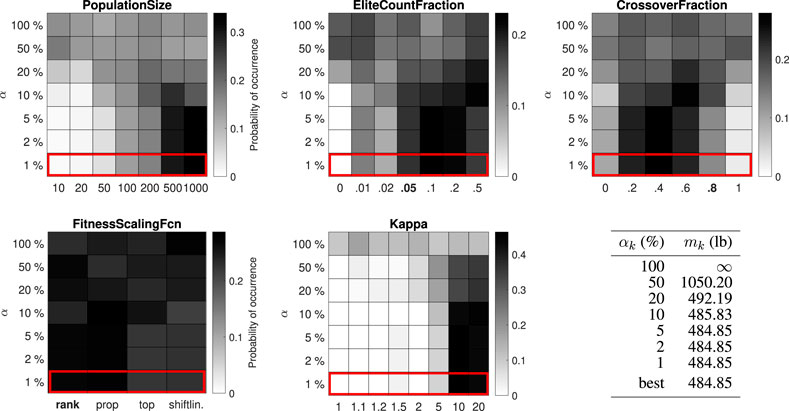
FIGURE 4. Distribution of control parameter values for the 25-bar truss test problem (8 design variables). The GA is limited to 105 function evaluations within a single run. The default value for the PopulationSize is 80, which is not present among the options.
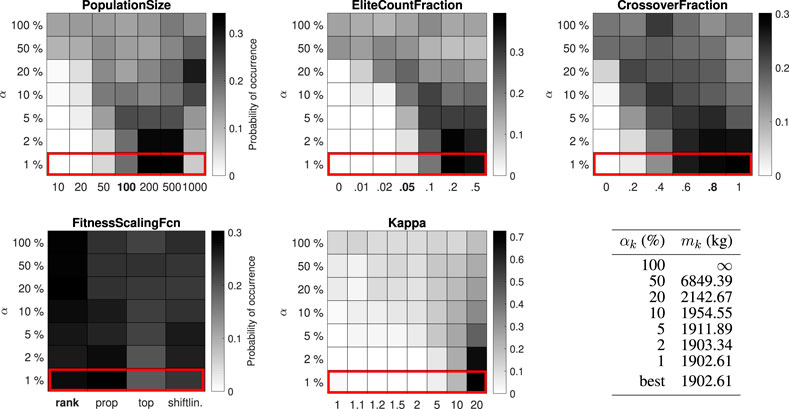
FIGURE 5. Distribution of control parameter values for the 52-bar truss test problem (12 design variables).
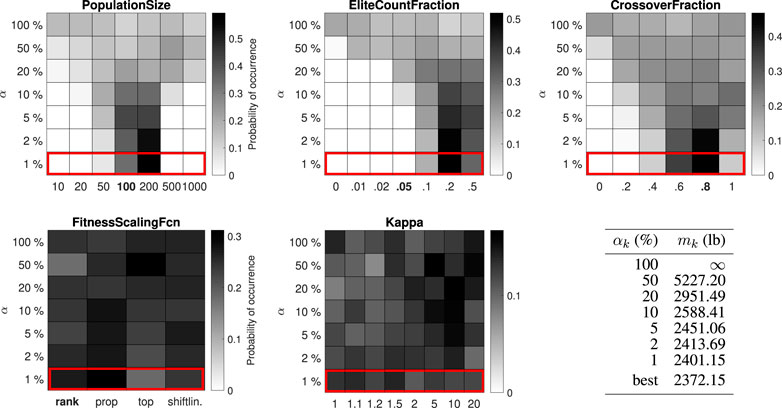
FIGURE 6. Distribution of control parameter values for the 47-bar truss test problem (27 design variables).
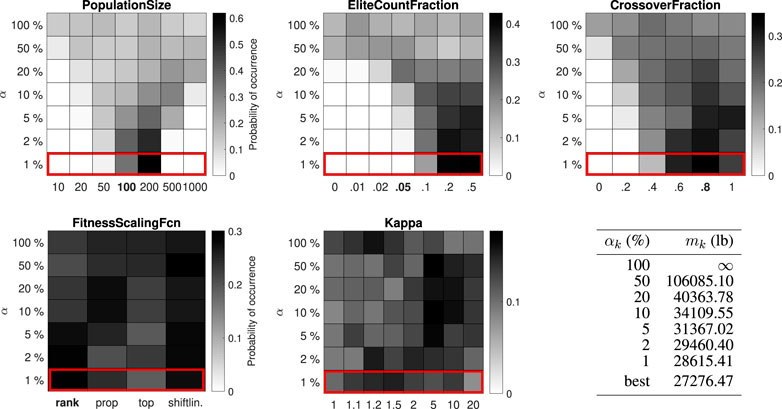
FIGURE 7. Distribution of control parameter values for the 200-bar truss test problem (29 design variables).
The best-performing value for the PopulationSize varies between 200 and 1,000 for the different test problems. The best-performing value for the EliteCountFraction ranges from 0.1 to 0.5. The best-performing value for the CrossoverFraction ranges from 0.4 to 1. The results for the FitnessScalingFcn are inconclusive, although the third option (“fitscalingtop”) consistently performs worse. For the small-scale problems (25-bar truss and 52-bar truss) the performance is higher with high values for the penalty parameter κ, while for the large-scale problems (47-bar truss and 200-bar truss) no significant difference can be observed.
For the 25-bar truss and 52-bar truss problems, the best objective function value from the simulation (484.85 lb and 1902.61 kg) is equal to the best solution in the literature. For the 47-bar truss and 200-bar truss problems, the best objective function value from the simulation (2372.15 and 27276.47 lb) is, to the authors’ best knowledge, slightly better than the best known solution in the literature (2376.02 and 27282.57 lb, associated design variables are given in Supplementary Appendix SB). With enhanced control parameter values, the GA has succeeded in improving the best known solution to the last two (well-studied) test problems, providing the community with new benchmark results while demonstrating the strength of the proposed method.
The number of sample runs and objective function evaluations performed in this experiment are listed in Table 3. They are of the same order of magnitude as reported for existing parameter tuning methods (Montero et al., 2014), depending on the accuracy of the estimates and the computational budget of the algorithm. Nevertheless, the computing power required to make the assessment is high. Investing such effort may be particularly relevant for optimizing parameters for a set of similar problems, for finding new benchmark results (optimal solutions) for the test problems, or for looking for general trends in important parameters and well-performing parameter values for specific types of optimization problems, such as discrete truss sizing optimization problems. The latter is investigated in the next paragraph.

TABLE 3. Summary of the computations for the 4 test problems, expressed as the number of sample runs and number of objective function evaluations (throughout the simulation).
Figure 8 summarizes the top 1% parameter value distributions of all problems in the test set, shown in order of increasing problem size (number of discrete solutions in the design space). Some trends do seem to emerge. The best-performing value for the PopulationSize decreases with the problem size, while the function evaluation limit remains constant, corresponding to an increasing number of allowable generations. The best-performing values for the EliteCountFraction and the CrossoverFraction generally increase with the problem size, although often multiple options perform similarly (e.g. CrossoverFraction equal to 0.6, 0.8 or 1 for the 52-bar truss problem or EliteCountFraction equal to 0.2 or 0.5 for the 200-bar truss problem). The results for FitnessScalingFcn are not statistically significant, but the second option (“fitscalingprop”) consistently performs well and the third option (“fitscalingtop”) always performs poorly. Good values for κ cannot be predicted based on the size of the optimization problem alone, although its effect is less important when the problem size is large. Robust parameter values (i.e. values that perform well for all test problems) are 200 for the PopulationSize, 0.2 for the EliteCountFraction and 0.6 or 0.8 for the CrossoverFraction. Robust values for FitnessScalingFcn are “fitscalingrank” (the default value) and “fitscalingprop.” Finally, a high value for κ is always a safe choice.

FIGURE 8. Comparison of the top 1% parameter value distributions for all optimization problems in the test set. The results are ordered according to the number of discrete solutions in the design space (the problem size).
The conclusions for the second experiment are as follows. For all test problems, the impact of the PopulationSize, the EliteCountFraction and the CrossoverFraction is significant, and the mode of the corresponding parameter value distribution becomes clearer as the problem size increases (with a fixed computational budget). Similar to the first experiment, the impact of the control parameters is larger when the computational budget is small. The best-performing value for the EliteCountFraction is consistently higher than the default value in matlab. The best-performing value for the CrossoverFraction varies, and seems to be proportional to the problem size. The best-performing value for the PopulationSize depends on the problem size and on the computational budget of the algorithm. The best-performing control parameter values found by the proposed method do not always match the default values in matlab.
4.3 Default vs. Optimized Control Parameter Values
The best-performing control parameter values found in the previous subsection are generally not the default values in matlab. Hence, the performance of the GA with default parameter values (listed in Table 4) is compared to the performance of the algorithm with optimized control parameter values (well-performing values from the previous subsection, listed in Table 5).
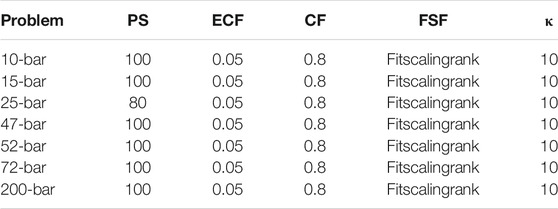
TABLE 4. Default values for the control parameters. Their names are abbreviated as follows: PopulationSize (PS), EliteCountFraction (ECF), CrossoverFraction (CF), FitnessScalingFcn (FSF), and penalty parameter κ.
The results of the comparison are summarized in Figure 9, using (custom) box plots. Each box plot represents 100 independent runs of the GA, with random starting points and a computational budget of 105 function evaluations. Infeasible solutions are given an objective function value of infinity. If (part of) a box plot is cut off at the top of the figure, it means that the corresponding objective function value goes to infinity.
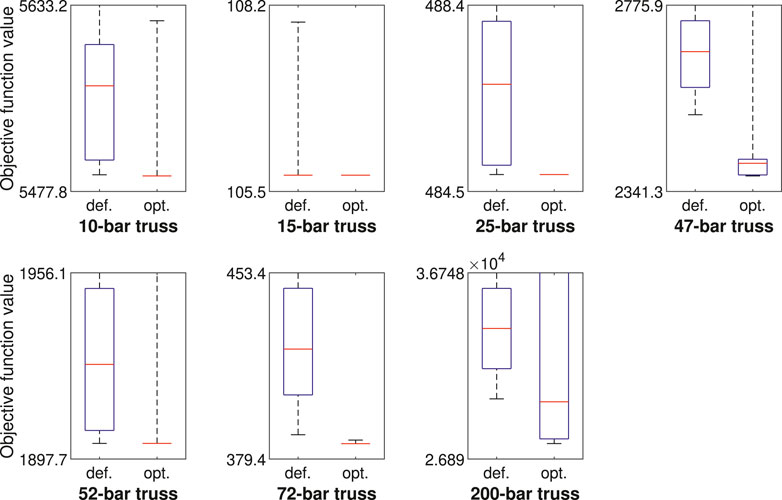
FIGURE 9. Summary of results of the GA when applied to the truss test problems, with default (def.) and optimized (opt.) control parameter values. The system (bottom whisker, box bottom, middle, top, top whisker) denotes the (minimum, 10-th percentile, median, 90-th percentile, maximum) objective function value in 100 independent runs of the GA.
The figure shows that the performance of the GA with optimized control parameter values is better than the performance with default values in almost all possible areas. For the 10-, 15-, 25- 52-, and 72-bar truss problems, the GA matches the best known solution in the literate in at least 90% of runs, and even in 100% of runs for the 15- and 25-bar truss problems, performing significantly better than with default control parameter values. For the 47-bar truss problem, the best result in the simulation (2377.5 lb) is slightly less good than the best result in the literature (2372.2 lb in this article, 2376.0 lb otherwise), but again the performance of the algorithm is considerably better than with default parameter values. For the 200-bar truss, the extremes of performance are amplified: the minimum, 10-th percentile and median objective function values are a lot better with optimized parameter values, although the algorithm more often converges to an infeasible design. With default control parameter values, at least one infeasible design is present among the results for 6 out of 7 test problems, compared to 3 out of 7 test problems in the case of optimized control parameter values.
5 Conclusions
A method has been developed to assess the performance of a metaheuristic algorithm in relation to the values of the control parameters. It is based on Monte Carlo sampling of independent algorithm runs and uses importance sampling as a variance reduction technique. The method is demonstrated using the genetic algorithm (GA) built into matlab for seven representative discrete truss sizing optimization problems that are commonly used in structural optimization literature. The method successfully captured the sensitivity of the GA with respect to the control parameters, identifying relevant parameters whose values need careful tuning as well as parameters that have little impact for the problems at hand. For the important control parameters, well-performing values are identified that consistently outperform the default matlab values for the benchmark problems considered.
The results in this study indicate that the impact of the control parameters is largest when the limit on the number of function evaluations is low. When the limit on the number of function evaluations is high, the algorithm becomes more robust to the values of its control parameters, affirming that longer computing times can (partially) compensate for poor parameter value choices.
The method described in this study can be used in a variety of ways. Information on the sensitivity of an optimization algorithm with respect to its control parameters can help developers to focus on the relevant part of their algorithm. In addition, the method can be used to select appropriate default values for the control parameters based on a representative set of test problems. The performance percentiles resulting from the simulation can be used to compare the algorithm with other metaheuristic algorithms. Finally, the Monte Carlo simulation may provide the academic community with new benchmark results, as illustrated by the improvements over the best designs reported so far in the literature for the 47-bar truss and the 200-bar truss test problems (found in Section 4 of this article).
Using the method to find good control parameter values is computationally expensive, as it requires several optimization runs to be performed. Therefore, it may be worthwhile to look for general guidelines regarding control parameter values that perform well. The results of all seven test problems have been compared to look for dependencies between well-performing parameter values and the number of discrete solutions in the design space. Robust parameter values (values that perform reasonably well for all problems in the test set) have been identified. For the test problems considered, it is found that the best-performing value for the PopulationSize of the GA heavily depends on the size of the optimization problem, and on the maximum number of function evaluations in a single run of the algorithm. Furthermore, it is found that the best-performing value for the EliteCountFraction is consistently higher than the default setting, and that the best-performing value for the CrossoverFraction is roughly proportional to the size of the design space.
Data Availability Statement
The source code of the example problems presented in the study are included in the article/Supplementary Material, further inquiries can be directed to the corresponding author.
Author Contributions
WD: methodology, software, analysis, writing, and editing. GL: conceptualization, methodology, supervision, reviewing. MS: conceptualization, methodology, supervision, reviewing.
Funding
This work has been performed in the frame of project C24/15/012 funded by the Industrial Research Fund of KU Leuven. The financial support is gratefully acknowledged.
Conflict of Interest:
The authors declare that the research was conducted in the absence of any commercial or financial relationships that could be construed as a potential conflict of interest.
Supplementary Material
The Supplementary Material for this article can be found online at: https://www.frontiersin.org/articles/10.3389/fbuil.2021.618851/full#supplementary-material.
Footnotes
1In a computer implementation, the random behavior of the algorithm will be determined by the seed that initializes the pseudorandom number generator. In this case,
2The current methodology is based on discrete random variables. The use of continuous variables in combination with kernel density estimation may be interesting for further research, but it is beyond the scope of this article.
3The EliteCountFraction is used to control the number of “elite” individuals in the GA (the value of EliteCount), which is computed as EliteCountFraction × PopulationSize, rounded to the nearest integer smaller than PopulationSize. The matlab default value for the EliteCount is 0.05 × PopulationSize for continuous problems and 0.05 × default PopulationSize for discrete problems. However, in this paper, the EliteCount is expressed as a fraction of the actual PopulationSize, indicating 0.05 as the default EliteCountFraction value.
References
Adenso-Díaz, B., and Laguna, M. (2006). Fine-tuning of algorithms using fractional experimental designs and local search. Operations Res. 54, 99–114. doi:10.1287/opre.1050.0243
Ansótegui, C., Sellmann, M., and Tierney, K. (2009). “A gender-based genetic algorithm for the automatic configuration of algorithms,” in International conference on principles and practice of constraint programming, Lisbon, Portugal, September, 2009 (Springer), 142–157.
Audet, C., and Orban, D. (2004). Finding optimal algorithmic parameters using a mesh adaptive direct search. Cahiers du GERAD G-2004-xx, 41.
Bäck, T., and Schwefel, H.-P. (1993). An overview of evolutionary algorithms for parameter optimization. Evol. Comput. 1, 1–23. doi:10.1162/evco.1993.1.1.1
Balaprakash, P., Birattari, M., and Stützle, T. (2007). “Improvement strategies for the F-Race algorithm: sampling design and iterative refinement,” in International workshop on hybrid metaheuristics, Dortmund, Germany, October, 2007 (Springer), 108–122.
Bartz-Beielstein, T. (2006). Experimental research in evolutionary computation. Berlin, Germany: Springer.
Bartz-Beielstein, T., Lasarczyk, C., and Preuß, M. (2005). “Sequential parameter optimization,” in IEEE congress on evolutionary computation. Edinburgh, United Kingdom, September, 2005 (IEEE), 1, 773–780.
Bartz-Beielstein, T., Parsopoulos, K. E., and Vrahatis, M. N. (2004). Design and analysis of optimization algorithms using computational statistics. Appl. Num. Anal. Comp. Math. 1, 413–433. doi:10.1002/anac.200410007
Birattari, M., Stützle, T., Paquete, L., and Varrentrapp, K. (2002). “A racing algorithm for configuring metaheuristics,” in Proceedings of the 4th annual conference on genetic and evolutionary computation, New York, United States (New York, NY: Morgan Kaufmann Publishers Inc.), 11–18.
Camp, C. V., and Bichon, B. J. (2004). Design of space trusses using ant colony optimization. J. Struct. Eng. 130, 741–751. doi:10.1061/(asce)0733-9445(2004)130:5(741)
Castillo-Valdivieso, P., Merelo, J., Prieto, A., Rojas, I., and Romero, G. (2002). Statistical analysis of the parameters of a neuro-genetic algorithm. IEEE Trans. Neural Netw. 13, 1374–1394. doi:10.1109/TNN.2002.804281
Charalampakis, A., and Tsiatas, G. (2019). Critical evaluation of metaheuristic algorithms for weight minimization of truss structures. Front. Built Environ. 5, 113. doi:10.3389/fbuil.2019.00113
Chiarandini, L., Preuss, M., Paquete, L., and Ridge, E. (2007). Experiments on metaheuristics: methodological overview and open issues. Technical report. Copenhagen (Denmark): Danish Mathematical Society.
Choquet, D., L’Ecuyer, P., and Léger, C. (1999). Bootstrap confidence intervals for ratios of expectations. ACM Trans. Model. Comput. Simul. 9, 326–348. doi:10.1145/352222.352224
Cornuet, J.-M., Marin, J.-M., Mira, A., and Robert, C. P. (2012). Adaptive multiple importance sampling. Scand. J. Stat. 39, 798–812. doi:10.1111/j.1467-9469.2011.00756.x
Coy, S. P., Golden, B., Runger, G., and Wasil, E. (2001). Using experimental design to find effective parameter settings for heuristics. J. Heuristics 7, 77–97. doi:10.1023/a:1026569813391
Czarn, A., MacNish, C., Vijayan, K., Turlach, B., and Gupta, R. (2004). Statistical exploratory analysis of genetic algorithms. IEEE Trans. Evol. Computat. 8, 405–421. doi:10.1109/tevc.2004.831262
De Jong, K. (1975). Analysis of the behavior of a class of genetic adaptive systems. PhD thesis. Ann Arbor (MI): University of Michigan, Computer and Communication Sciences Department.
Degertekin, S. O., Lamberti, L., and Ugur, I. B. (2019). Discrete sizing/layout/topology optimization of truss structures with an advanced Jaya algorithm. Appl. Soft Comput. 79, 363–390. doi:10.1016/j.asoc.2019.03.058
Dillen, W., Lombaert, G., Voeten, N., and Schevenels, M. (2018). “Performance assessment of metaheuristic algorithms for structural optimization taking into account the influence of control parameters,” in Proceedings of the 6th international conference on engineering optimization (Lisbon, Portugal: Springer), 93–101.
Dobslaw, F. (2010). “A parameter tuning framework for metaheuristics based on design of experiments and artificial neural networks,” in International Conference on computer Mathematics and natural computing (WASET), Rome, Italy, April, 2010.
Dolan, E. D., and Moré, J. J. (2002). Benchmarking optimization software with performance profiles. Math. Programming 91, 201–213. doi:10.1007/s101070100263
Eiben, A. E., and Smit, S. K. (2011). Parameter tuning for configuring and analyzing evolutionary algorithms. Swarm Evol. Comput. 1, 19–31. doi:10.1016/j.swevo.2011.02.001
Falkner, S., Klein, A., and Hutter, F. (2018). “Bohb: robust and efficient hyperparameter optimization at scale,” in Proceedings of the 35th international conference on machine learning (ICML), Stockholm, Sweden, July, 2018.
Georgioudakis, M., and Plevris, V. (2020). A comparative study of differential evolution variants in constrained structural optimization. Front. Built Environ. 6, 102. doi:10.3389/fbuil.2020.00102
Gholizadeh, S., Danesh, M., and Gheyratmand, C. (2020). A new Newton metaheuristic algorithm for discrete performance-based design optimization of steel moment frames. Comput. Structures 234, 106250. doi:10.1016/j.compstruc.2020.106250
Gomes, W. J. S., Beck, A. T., Lopez, R. H., and Miguel, L. F. F. (2018). A probabilistic metric for comparing metaheuristic optimization algorithms. Struct. Saf. 70, 59–70. doi:10.1016/j.strusafe.2017.10.006
Grefenstette, J. (1986). Optimization of control parameters for genetic algorithms. IEEE Trans. Syst. Man. Cybern. 16, 122–128. doi:10.1109/tsmc.1986.289288
Haftka, R. T. (2016). Requirements for papers focusing on new or improved global optimization algorithms. Struct. Multidisc Optim. 54, 1. doi:10.1007/s00158-016-1491-5
Hammersley, J., and Handscomb, D. (1964). Monte Carlo methods. Berlin, Germany: Springer Science and Business Media.
Hasançebi, O. (2008). Adaptive evolution strategies in structural optimization: enhancing their computational performance with applications to large-scale structures. Comput. Structures 86, 119–132. doi:10.1016/j.compstruc.2007.05.012
Hasançebi, O., Erdal, F., and Saka, M. (2009). Adaptive harmony search method for structural optimization. J. Struct. Eng. 136, 419–431. doi:10.1061/(ASCE)ST.1943-541X.0000128
Ho-Huu, V., Nguyen-Thoi, T., Vo-Duy, T., and Nguyen-Trang, T. (2016). An adaptive elitist differential evolution for optimization of truss structures with discrete design variables. Comput. Structures 165, 59–75. doi:10.1016/j.compstruc.2015.11.014
Hooker, J. N. (1995). Testing heuristics: we have it all wrong. J. Heuristics 1, 33–42. doi:10.1007/bf02430364
Hutter, F., Hoos, H. H., Leyton-Brown, K., and Stuetzle, T. (2009b). ParamILS: an automatic algorithm configuration framework. JAIR 36, 267–306. doi:10.1613/jair.2861
Hutter, F., Hoos, H., Leyton-Brown, K., and Murphy, K. (2009a). “An experimental investigation of model-based parameter optimisation: SPO and beyond,” in Proceedings of the 11th Annual conference on Genetic and evolutionary computation, Montréal, Canada, July, 2009 (ACM), 271–278.
Hutter, F., Hoos, H., Leyton-Brown, K., and Murphy, K. (2010). “Time-bounded sequential parameter optimization,” in International conference on learning and intelligent optimization, Kalamata, Greece, June, 2010 (Springer), 281–298.
Hutter, F., Hoos, H., and Leyton-Brown, K. (2011). “Sequential model-based optimization for general algorithm configuration.” in International conference on learning and intelligent optimization, Rome, Italy, January, 2011 (Springer), 507–523.
Jaynes, E. (2003). Probability theory: the logic of science. Cambridge, United Kingdom: Cambridge University Press.
Karafotias, G., Hoogendoorn, M., and Eiben, A. E. (2015). Parameter control in evolutionary algorithms: trends and challenges. IEEE Trans. Evol. Computat. 19, 167–187. doi:10.1109/tevc.2014.2308294
Kaveh, A., and Farhoudi, N. (2011). A unified approach to parameter selection in meta-heuristic algorithms for layout optimization. J. Constructional Steel Res. 67, 1453–1462. doi:10.1016/j.jcsr.2011.03.019
Kolmogorov, A. (1956). Foundations of the theory of probability. New York, NY: Chelsea Publishing Company.
Le Riche, R., and Haftka, R. T. (2012). On global optimization articles in SMO. Struct. Multidisc Optim. 46, 627–629. doi:10.1007/s00158-012-0785-5
Lee, K. S., Geem, Z. W., Lee, S.-h., and Bae, K.-W. (2005). The harmony search heuristic algorithm for discrete structural optimization. Eng. Optimization 37, 663–684. doi:10.1080/03052150500211895
Lepage, G. (1978). A new algorithm for adaptive multidimensional integration. J. Comput. Phys. 27, 192–203.
Li, L., Jamieson, K., DeSalvo, G., Rostamizadeh, A., and Talwalkar, A. (2017). Hyperband: a novel bandit-based approach to hyperparameter optimization. J. Machine Learn. Res. 18, 6765–6816.
López-Ibáñez, M., Dubois-Lacoste, J., Pérez Cáceres, L., Birattari, M., and Stützle, T. (2016). The irace package: iterated racing for automatic algorithm configuration. Operations Res. Perspect. 3, 43–58. doi:10.1016/j.orp.2016.09.002
McGill, R., Tukey, J. W., and Larsen, W. A. (1978). Variations of box plots. The Am. Statistician 32, 12–16. doi:10.2307/2683468
Montero, E., Riff, M.-C., and Neveu, B. (2014). A beginner’s guide to tuning methods. Appl. Soft Comput. 17, 39–51. doi:10.1016/j.asoc.2013.12.017
Moré, J. J., and Wild, S. M. (2009). Benchmarking derivative-free optimization algorithms. SIAM J. Optim. 20, 172–191. doi:10.1137/080724083
Myers, R., and Hancock, E. (2001). Empirical modelling of genetic algorithms. Evol. Comput. 9, 461–493. doi:10.1162/10636560152642878
Nannen, V., and Eiben, A. (2007). Relevance estimation and value calibration of evolutionary algorithm parameters. IJCAI 7, 975–980. doi:10.1109/CEC.2007.4424460
Nickabadi, A., Ebadzadeh, M. M., and Safabakhsh, R. (2011). A novel particle swarm optimization algorithm with adaptive inertia weight. Appl. Soft Comput. 11, 3658–3670. doi:10.1016/j.asoc.2011.01.037
Ogliore, R. C., Huss, G. R., and Nagashima, K. (2011). Ratio estimation in SIMS analysis. Nucl. Instrum. Methods Phys. Res., B 269, 1910–1918. doi:10.1016/j.nimb.2011.04.120
Owen, A., and Zhou, Y. (2000). Safe and effective importance sampling. J. Am. Stat. Assoc. 95, 135–143. doi:10.1080/01621459.2000.10473909
Owen, A., and Zhou, Y. (1999). Adaptive importance sampling by mixtures of products of beta distributions. Technical report. Stanford (CA): Stanford University.
Rajeev, S., and Krishnamoorthy, C. S. (1992). Discrete optimization of structures using genetic algorithms. J. Struct. Eng. 118, 1233–1250. doi:10.1061/(asce)0733-9445(1992)118:5(1233)
Rardin, R. L., and Uzsoy, R. (2001). Experimental evaluation of heuristic optimization algorithms: a tutorial. J. Heuristics 7, 261–304. doi:10.1023/a:1011319115230
Rechenberg, I. (1973). Evolution strategy: optimization of technical systems by means of biological evolution. Frommann-Holzboog, Stuttgart 104, 15–16.
Richardson, J., Palmer, M., Liepins, G., and Hilliard, M. (1989). “Some guidelines for genetic algorithms with penalty functions, in Proceedings of the 3rd international conference on genetic algorithms, Fairfax, VA, June, 1989 (Morgan Kaufmann Publishers Inc.), 191–197.
Rudolph, G. (1994). Convergence analysis of canonical genetic algorithms. IEEE Trans. Neural Netw. 5, 96–101. doi:10.1109/72.265964
Sacks, J., Welch, W. J., Mitchell, T. J., and Wynn, H. P. (1989). Design and analysis of computer experiments. Statist. Sci., 4, 409–423. doi:10.1214/ss/1177012413
Stuart, A., and Ord, J. (1994). Kendall’s advanced theory of statistics. 6 Edn. London, United Kingdom: Edward Arnold, 1.
Wolpert, D. H., and Macready, W. G. (1997). No free lunch theorems for optimization. IEEE Trans. Evol. Computat. 1, 67–82. doi:10.1109/4235.585893
Xu, J., Chiu, S. Y., and Glover, F. (1998). Fine-tuning a tabu search algorithm with statistical tests. Int. Trans. Oper. Res. 5, 233–244. doi:10.1111/j.1475-3995.1998.tb00117.x
Keywords: stochastic optimization, genetic algorithm, statistical analysis, parameter tuning, algorithm configuration, hyperparameter optimization, monte carlo simulation
Citation: Dillen W, Lombaert G and Schevenels M (2021) Performance Assessment of Metaheuristic Algorithms for Structural Optimization Taking Into Account the Influence of Algorithmic Control Parameters. Front. Built Environ. 7:618851. doi: 10.3389/fbuil.2021.618851
Received: 18 October 2020; Accepted: 22 January 2021;
Published: 11 March 2021.
Edited by:
Nikos D. Lagaros, National Technical University of Athens, GreeceCopyright © 2021 Dillen, Lombaert and Schevenels. This is an open-access article distributed under the terms of the Creative Commons Attribution License (CC BY). The use, distribution or reproduction in other forums is permitted, provided the original author(s) and the copyright owner(s) are credited and that the original publication in this journal is cited, in accordance with accepted academic practice. No use, distribution or reproduction is permitted which does not comply with these terms.
*Correspondence: Mattias Schevenels, bWF0dGlhcy5zY2hldmVuZWxzQGt1bGV1dmVuLmJl
 Wouter Dillen
Wouter Dillen Geert Lombaert
Geert Lombaert Mattias Schevenels
Mattias Schevenels
